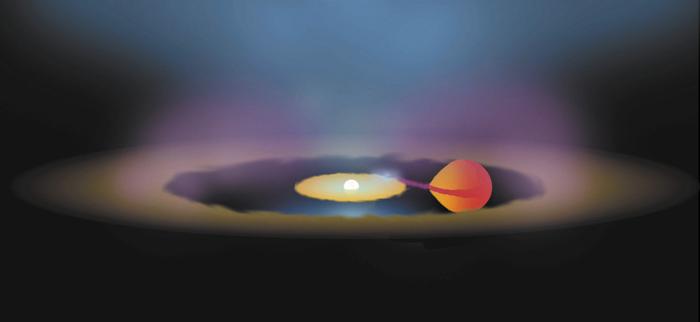Gas Disks Surrounding Binary Stars |
Researchers at the Max Planck Institute for Astrophysics propose that many close binary stars are surrounded by (so far unseen) disks of gas which affect their evolution, and would explain the very high luminosity of some dwarf novae, as well as some enigmatic properties of `Black Hole binaries'.

|
| Figure 1 |
The image shows an `artist's impression' of a binary star consisting of a white dwarf star (white dot at the center), and a normal star orbiting around it (shown in red). They are so close that mass is pulled off the red star and flows to the white dwarf. Before settling on the white dwarf, it orbits many times around, forming a so-called accretion disk (yellow). Images like this can not be made with telescopes because the whole configuration is very small, but many indirect observations prove that objects like novae, dwarf novae and the so-called Black Hole binaries (in which the white dwarf at the center is replaced by a black hole) must look much like this. These observations also show that some gas is flowing off the disk in the form of a tenuous `wind' (shown in the picture as blue and purple haze).
The new proposal is now that some of the gas in this wind moves so slowly (the purple haze) that it does not leave the binary but instead settles into a disk surrounding it (the wide brown ring). Over the hundreds of millions of years that the binary exists, the amount accumulated in this `circumbinary disk' can be large enough to affect the binary itself. Alternatively, a circumbinary disk might exist as a leftover from the process by which the binary got into its present narrow orbit. Tides raised in the circumbinary disk by the red star act back on the binary, like the tidal interaction between the earth and the moon. As a result the red star loses some of its motion, forcing it into a narrower orbit. In order to fit into such a smaller orbit, it must transfer more of its mass to the white dwarf, causing the accretion disk to brighten. This would explain the puzzlingly bright accretion disks observed in some binary systems, as well as a number of other poorly understood observations.
The crucial question is of course: if these circumbinary disks exist, can't we observe them somehow? Calculations of their predicted brightnes show that they must be quite faint, however, even if they contain a substantial amount of mass. The best chances of detection them will be at infrared wavelengths, where these binaries have only been poorly observed so far. A program of such infrared observations is under way.
| MPA-Home |